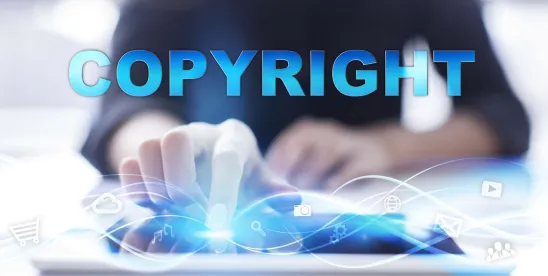On January 29, 2025, the Copyright Office (USCO) issued the second of its three-part report, Copyright and Artificial Intelligence, relating to its study of how copyright law and policy should respond to the development and use of artificial intelligence. The report grows out of the USCO’s Notice of Inquiry issued in August of 2023, which garnered over 10,000 responses from the public, including from businesses, trade associations, academics, non-profits, artists, and computer scientists. Part 2 deals with the copyrightability of AI-generated materials. Part 1, issued on December 16, 2024, discussed “digital replicas” (digital depictions of an individual) and proposed a new federal law to fill the gap in coverage of existing copyright law and other aligned areas such as rights of publicity. Part 3, expected in early 2025, will discuss the use of copyrighted works for training AI models.
In Part 2, the USCO concludes that existing law on copyrightability adequately accommodates AI-generated output and accordingly makes no recommendation for legislative action. The Copyright Act grants authors limited monopolies on their creations to assure that they have sufficient incentive to create and thereby to enrich culture (i.e., in the language of Article I, Section 8: “to promote the progress of the Arts and Sciences”). As interpreted, authors must be humans. Thaler v. Perlmutter, 687 F. Supp. 3d 140, 149–50 (D.D.C. 2023), Notice of Appeal, No. 23-5233 (D.C. Cir. October 18, 2023 (argued September 19, 2024).
Although the requirement of human authorship would appear, at present, to preclude AI-generated work from receiving copyright protection under the Copyright Act, the USCO considered the pros and cons of creating a new sui generis protection targeted at AI-generated works (perhaps a more limited protection). In support of such protection, it is worth noting that a robust repository of work, even if created by non-human actors, would arguably further the goal of promoting the Arts and Sciences (and therefore argue in favor of such protection). Such protection might also encourage many people (e.g., the non-professional) to participate in the excitement of creation and to express themselves, and even monetize those expressions, in ways they never dreamed.
The USCO was ultimately not persuaded by these arguments. Focusing initially on the AI technology itself, the USCO noted that unlike humans, machines, software, and algorithms need no incentive to create and therefore need no protection. The USCO was also cautious about increasing incentives to rely on AI-generated works and the concomitant creation of a synthetically diluted culture at the expense of a robust and perpetually renewing repository of human creativity. See Part 2, at 36-37. Citing as evidence the recent challenges faced by writers and musicians, the USCO was also sympathetic to concerns that such reliance might dampen the ability of human creators to monetize their works and thereby degrade the societal incentive to create. The USCO determined that the case of persons with disabilities did not require a different result. Noting its strong support for the empowerment of all creators, the USCO noted that AI is used as an assistive technology to facilitate human creation. Copyright protection remains available so long as it is used as a tool to recast, transform, or adapt an author’s expression and not to generate that expression. The USCO provided the example of singer Randy Travis who received a copyright registration for a song he created after suffering a stroke, under circumstances where he used AI to recreate his voice and help realize the musical sounds that he and his musical team desired. Part 2, at 37-38.
Acknowledging that a work must be “authored” by a human to receive protection, humans can play a variety of roles in creating AI-generated works. When does human activity rise to authorship? The USCO devoted a large part of its discussion, perhaps the most interesting part, to this question, the answer to which, as explained by the USCO, is rooted in copyright law’s distinction between ideas and expression. Only the latter is protected under copyright law (17 U.S.C. § 102(b)).
AI output is typically generated by user inputs (“prompts”), often in the form of text (e.g., “draw an image of dolphins at a birthday party”). Typical prompts, according to the USCO, contain merely unprotectible ideas that are then translated by AI into expression. These translation processes are largely random (“black box”) processes that are not predictable or understood by the user. The USCO noted that frequently the output includes many items that were not specified and excludes items that were, and the same prompt often can yield very different results. Viewed in this light, the AI process is akin to the novel writer who translates the high-level suggestions of his or her editor, or the scriptwriter who follows the general ideas and suggestions of a movie treatment. The suggestions of the editor do not make him or her an author of the novel, and the treatment does not make its creator an author of the script for the movie. Community for Creative Non-Violence v. Reid, 490 U.S. 730, 737 (1989) (“person who translates an idea into a fixed, tangible expression entitled to copyright protection”) (emphasis added), cited in Part 2 at 9; cf., Andrien v. Southern Ocean County Chamber of Commerce, 927 F.2d 132, 135 (3d Cir. 1991) cited in Part 2 at 9 (“[A] party can be considered an author when his or her expression of an idea is transposed by mechanical or rote transcription into tangible form under the authority of the party”) (emphasis added); Milano v. NBC Universal, Inc., 584 F. Supp. 2d 1288, 1294 (C.D. Cal. 2008), citing and quoting from Berkic v. Crichton, 761 F.2d 1289, 1293 (9th Cir.1985) (distinguishing a television treatment from “the actual concrete elements that make up the total sequence of events and the relationships between the major characters”).
Importantly, even a detailed string of prompts, involving a selection and adoption process leading iteratively to the final output, does not, according to the USCO, confer the requisite control for authorship. As stated in Part 2 (at 20):
“Repeatedly revising prompts does not change this analysis or provide a sufficient basis for claiming copyright in the output. . . . By revising and submitting prompts multiple times, the user is “re-rolling” the dice, causing the system to generate more outputs from which to select, but not altering the degree of control over the process. No matter how many times a prompt is revised and resubmitted the final output reflects the user’s acceptance of the AI system’s interpretation, rather than authorship of the expression it contains.”
This conclusion may be hard to swallow for some. The iterative process more or less reflects the way many artists work, adopting small random acts on the page or canvas into integral parts of their work. Action painting of Jackson Pollock (referenced in Part 2), involving the dripping of paint on a canvas, is only a more extreme example of this regular phenomenon. While acknowledging a certain randomness in both prompting and the artistic process, the USCO distinguished the latter by the control that the artist, unlike the AI user, exerts physically over a process that is transparent and understood. “Jackson Pollock’s process of creation,” said the USCO, “did not end with his vision of a work. He controlled the choice of colors, number of layers, depth of texture, placement of each addition to the overall composition – and used his own body movements to execute each of these choices.” Part 2 at 20.
The approach of the USCO differs markedly from a highly publicized case in China, cited by the USCO at 28-29, which accorded copyright protection to an Image created by using Stable Diffusion and recognized the person using the AI tool as the author. In addition to making subsequent adjustments and modifications, the “author” used over 150 prompts to refine the image. As distinguished from the USCO’s position on iterative prompts, the court in that case considered the use of prompts as evidence of the control and creativity exerted by the author. The spirit of the Chinese court’s ruling is in striking contrast to the USCO’s:
“Therefore, when people use an AI model to generate pictures, there is no question about who is the creator. In essence, it is a process of man using tools to create, that is, it is man who does intellectual investment throughout the creation process, [not the] AI model. The core purpose of the copyright system is to encourage creation. And creation and AI technology can only prosper by properly applying the copyright system and using the legal means to encourage more people to use the latest tools to create. Under such context, as long as the AI-generated images can reflect people’s original intellectual investment, they should be recognized as works and protected by the Copyright Law.”
Li v. Liu, Dispute over Copyright Infringement of the Right of Attribution and Right of Information Network Distribution of works (as translated), at 13 (Beijing Internet Ct. November 27, 2023).
Various statutes in UK, Hong Kong, New Zealand, and India, though created before the proliferation of AI over the last couple of years, allow for computer-generated works to be copyrightable in the name of the person causing the creation of the work. The USCO noted that it remains to be seen how foreign countries interpret and apply their laws, how they harmonize their laws among themselves, and how content creators and information technology developers respond to these emerging laws. Part 2, at 29. Finally, with respect to its own conclusions on prompts, the USCO left open the possibility that advances in technology giving humans more control over generated content might merit a reevaluation of the conclusions in the report. Part 2, at 21.
Less nuanced, and perhaps less debatable than its conclusions with respect to prompts, were some of the USCO’s other conclusions. For example, even if a particular output might not be protectible, the creativity embodied in a modification of an AI output (the derivative aspects) may well be protectible. Likewise, if certain AI-generated components are themselves not protectible, a human compilation of those components may well be (e.g., organizing/compiling the AI-generated frames of a graphic novel or comic book). Additionally, the USCO noted that creative prompts (e.g., a drawing combining flowers and a human head) may result in a protectible AI image to the extent that the image transcribes the prompt. Finally, the USCO saw no need to enhance protections for AI Technologies themselves and noted that first-mover incentives along with existing copyright, patent, and trade secret protections for such technologies are sufficient.
For entities in the U.S. wanting to assure ownership of their creative works, the USCO’s position on AI-generated content might induce a bit of caution in using AI in the creative process, and it may offer some relief, at least at the margins, for people whose livelihood depends on their human creativity. Of course, ultimately it will be Congress and the courts that decide the direction of U.S. law.




 />i
/>i

